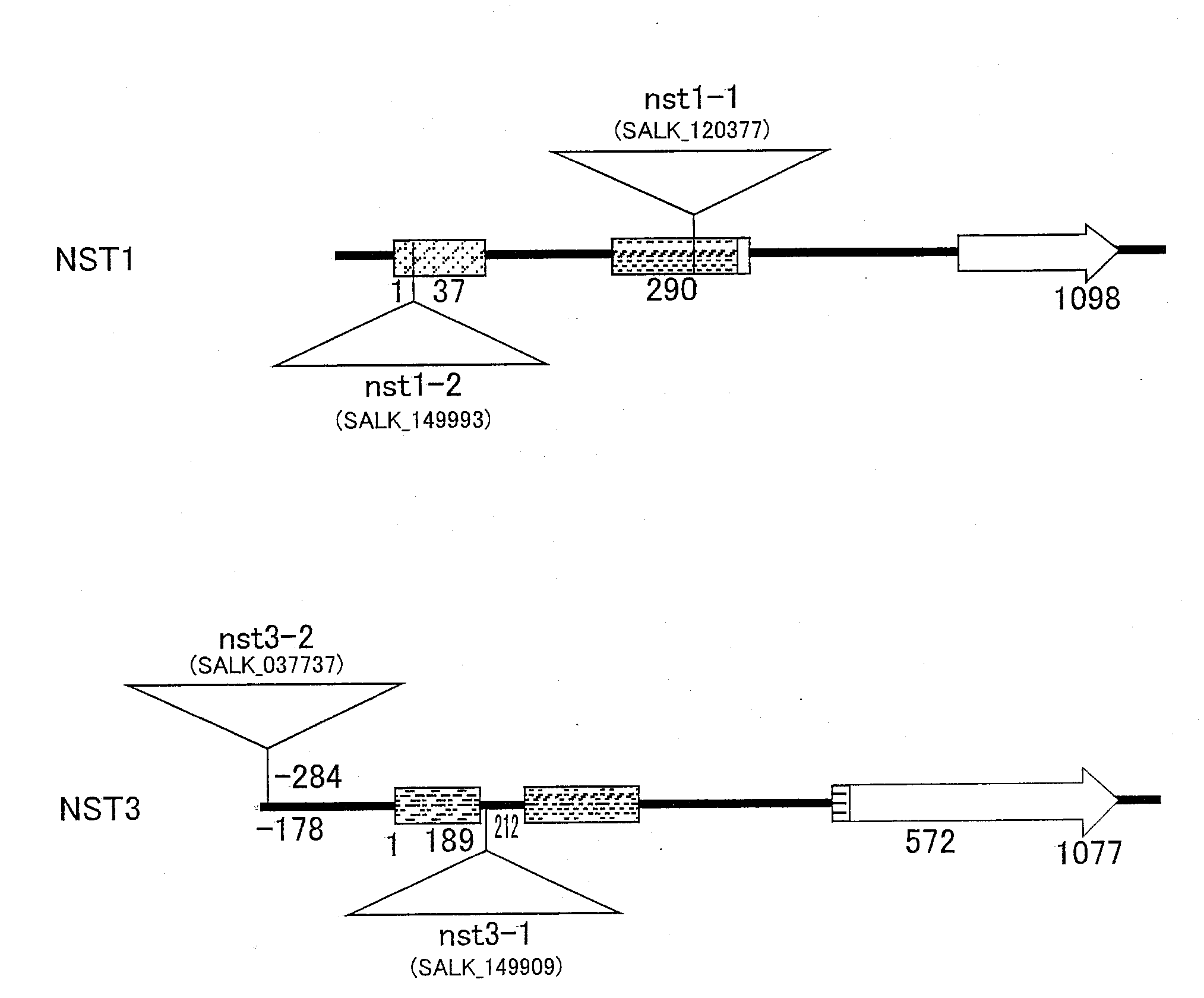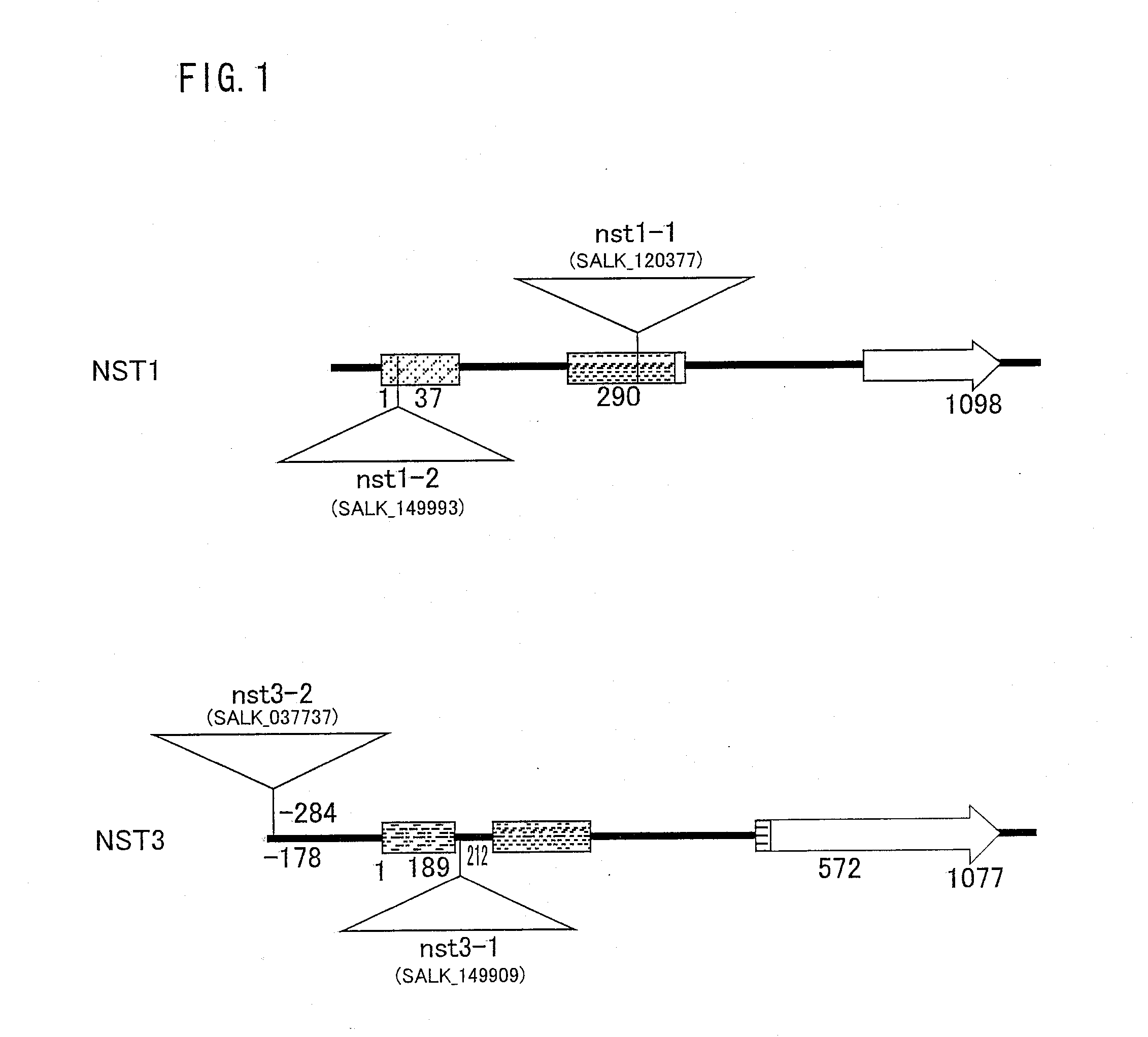Plant having reduced lignin and cellulose contents without reducing glucan content, method of producing the same and utilization thereof
a technology of lignin and cellulose, which is applied in the field of plant having reduced lignin and cellulose contents without reducing glucan content, method of producing the same, and utilization thereof, can solve the problems of reducing the amount of crystalline cellulose in a plant without reducing the amount, and the amount of glucan is not known, so as to suppress the natural dehiscence of the pods
- Summary
- Abstract
- Description
- Claims
- Application Information
AI Technical Summary
Benefits of technology
Problems solved by technology
Method used
Image
Examples
example 1
Production of NST1 / NST3 Gene Disruption Plant
[0286]In the present example, (i) seeds of plants in which the function of a transcription factor encoded by NST1 gene of Arabidopsis thaliana was disrupted (NST1 T-DNA-TAG LINES: SALK—120377 and SALK—149993) and (ii) seeds of a plant in which the function of a transcription factor encoded by NST3 gene of Arabidopsis thaliana was disrupted (NST3 T-DNA-TAG LINE: SALK—149909) were obtained from T-DNA-tagged lines (T-DNA insertion mutant lines) produced by the SALK INSTITUTE in U.S.A.
[0287]FIG. 1 is a schematic diagram illustrating the positions where T-DNAs were inserted in gene sequences of SALK—120377, SALK—149993, and SALK—149909. With the T-DNAs inserted at the positions of the respective gene sequences, NST 1 loses the function of a transcription factor in SALK—120377 and SALK—149993, and NST3 also loses the function of a transcription factor in SALK—149909.
[0288]In all of the seeds of the plants of three kinds, homozygous plants and h...
example 2
Effects of Transcription Factor NST1 or Transcription Factor NST3 on Synthesis of Lignin
[0293]For comparison between the effects of a transcription factor NST1 and a transcription factor NST3 on the synthesis of lignin, the following plants were grown: wild-type Arabidopsis thaliana (represented by wt in FIGS. 2 through 5 and Table 2) as a control; SALK—120377 (represented by nst1 in FIGS. 2 through 4) that was a plant in which the function of NST1 was disrupted; SALK—149909 (represented by nst3 in FIGS. 2 through 4) that was a plant in which the function of NST3 was disrupted; and the NST1 / NST3 gene disruption plant (represented by nst1 / nst3 in FIGS. 2 through 5 and Table 2) that was a plant in which both of the functions of NST1 and NST3 were disrupted. Comparison between the plants was made in terms of the degree of growth and the amount of lignin in inflorescence stems and hypocotyls of the plants.
[0294]FIG. 2 shows photomicrographs (line A) of inflorescence stem slices of the f...
example 3
Effects of Transcription Factor NST1 or Transcription Factor NST3 on Natural Dehiscence of Pods
[0302]As in Example 2, wild-type Arabidopsis thaliana, SALK—120377, SALK—149909, and NST1 / NST3 gene disruption plant were grown, and these plants produced seeds. Respective pods of the plants were collected, and pod slices were prepared according to the following procedure.
[0303]Each of Arabidopsis thaliana pods was collected and then immersed and fixed in a FAA fixing solution (45% ethanol, 2.5% acetic acid, 2.5% formalin) for 12 hours. The fixed pod was immersed in (1) a mixture solution of 40% ethanol and 10% tertiary butyl alcohol, (2) a mixture solution of 50% ethanol and 20% tertiary butyl alcohol, (3) a mixture solution of 50% ethanol and 35% tertiary butyl alcohol, (4) a mixture solution of 45% ethanol and 55% tertiary butyl alcohol, and (5) a mixture solution of 25% ethanol and 75% butyl alcohol, in this order each for 30 minutes. After immersed in the mixture solution (5), the po...
PUM
| Property | Measurement | Unit |
|---|---|---|
| wavelength | aaaaa | aaaaa |
| wavelength | aaaaa | aaaaa |
| length | aaaaa | aaaaa |
Abstract
Description
Claims
Application Information
 Login to View More
Login to View More - R&D
- Intellectual Property
- Life Sciences
- Materials
- Tech Scout
- Unparalleled Data Quality
- Higher Quality Content
- 60% Fewer Hallucinations
Browse by: Latest US Patents, China's latest patents, Technical Efficacy Thesaurus, Application Domain, Technology Topic, Popular Technical Reports.
© 2025 PatSnap. All rights reserved.Legal|Privacy policy|Modern Slavery Act Transparency Statement|Sitemap|About US| Contact US: help@patsnap.com



